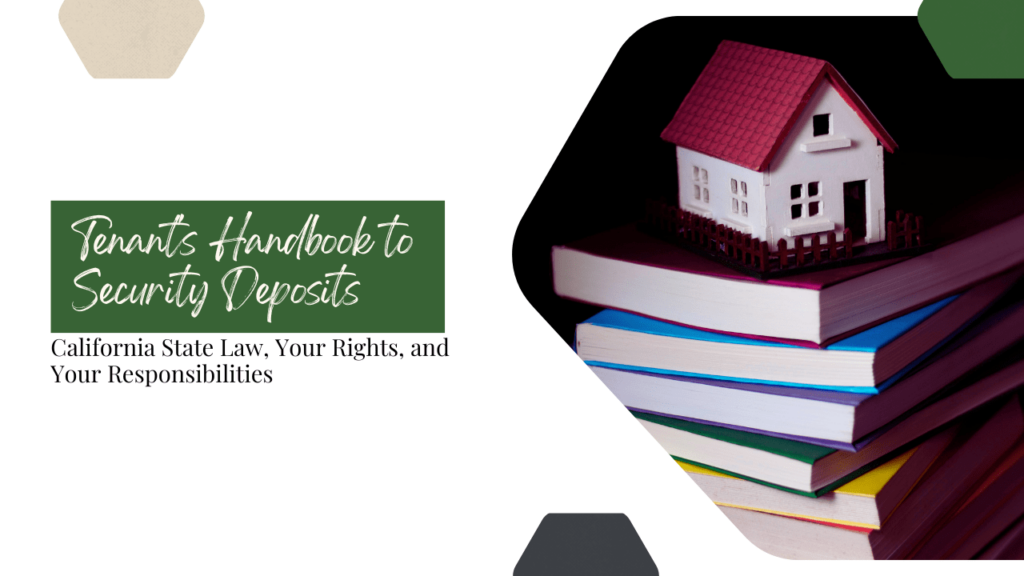
As a tenant in Sonoma County, CA, dealing with rental agreements and security deposits can be challenging. D & G Equity Management can help educate you about the details. This guide breaks down California State Law about security deposits into more understandable terms. We’ll cover your rights and responsibilities, ensuring you are well-informed and have the knowledge and confidence to manage this important part of renting a home.
The Basics of Security Deposits in California
Security deposits are a standard part of rental agreements in California, serving as a financial safety net for Housing Providers. These deposits are intended to protect property owners from potential losses or damages that might occur during a tenancy. As a tenant, understanding the legal framework surrounding these deposits is essential. It not only helps in knowing what you’re accountable for, but also ensures that your rights are protected when it comes to the return of the deposit at the end of tenancy.
Limits on Security Deposit Amounts
As of today, California law sets clear limits on how much a landlord can charge for a security deposit. For an unfurnished property, the limit is up to two months’ rent; for a furnished one, it’s up to three months’ rent. Knowing these limits can help you assess whether your landlord’s demands are within legal bounds. Starting July 1st, 2024, Assembly Bill 12 (AB 12) will significantly change the regulations concerning security deposits in California. From that time forward, landlords will be limited to demanding a security deposit equivalent to only one month’s rent, regardless of whether the property is furnished or not. There are exceptions to charging security deposits. Refer to Assembly Bill 12 (AB 12).
Purpose of Security Deposits
The security deposit you pay at the start of your tenancy can be used by your landlord to cover:
- Unpaid rent and any billed utilities
- Repair costs for damage to the rental property beyond normal wear and tear
- Cleaning expenses to return the property to its initial state, minus normal wear and tear
- Other breaches of the lease agreement
Understanding these purposes can help you avoid disputes over your security deposit when you move out of the rental property.
A Tenant has the option to request a pre-move out inspection 2 weeks prior to vacating the premises. The Housing Provider, tenant meet at the premises and go over the components that the tenant is responsible for completing up vacating the premises. Tenant and Housing provider sign/date an agreement of those items.
Understanding Property Damage vs. Normal Wear and Tear
According to California law, normal wear and tear refers to the inevitable deterioration of a property over time due to normal, everyday use. Examples include minor scuffs on walls, faded paint, or worn carpeting. Landlords should not keep your security deposit for these small things.
On the other hand, if there’s damage that’s more serious, like big holes in the walls, windows that are broken, or bad stains on the carpet (just to name a few), that’s a different story. This kind of damage is more than just everyday living – it’s usually due to accidents or carelessness. It also can result from not taking care of the place. For these types of property damage, landlords are within their rights to use the security deposit for repairs.
As a tenant, knowing this difference helps you understand what you should be doing to take care of the property, inside and out. It can also help to meet your expectations at the end of your tenancy when it’s time to get your security deposit back.
It’s highly recommended that the Housing Provider before a tenant taking occupancy to document in writing a move in report noting the existing condition of the property along with move in photos. At the time of occupancy, tenant is to sign and date the move in report document. This will help illuminate discrepancies when it comes time to return the deposit. Refer to “Tenants Rights Under California State Law”, “Document Everything”
Returning the Property to Its Initial State at Move-In
Many tenants believe that a thorough cleaning of their rental property is sufficient to return it to its original condition and get their full security deposit. However, the reality often involves more detailed and specific actions:
Cleaning vs. Repairing: While cleaning is essential, it’s just one part of the process. Any damages tenants might have caused to the rental property (as outlined above) must also be repaired. Furthermore, any intentional and Housing Provider approved changes a tenant has made to the property, like painting walls or installing shelves, should be reverted back to their original state. Please note that if the Housing Provider did not agree to these updates, they are a breach of the lease agreement.
Professional Services: While a tenant may believe themselves to be thorough and handy, often the repairs are not up to the property owner’s standard. Certain items, like carpet cleaning might require professional services to meet that standard expected by the landlord or outlined in the lease agreement.
Tenants’ Rights Under California State Law
As a tenant in Sonoma County, California State Law affords you certain rights regarding your security deposit:
- Receipt of Deposit: When you pay your security deposit, you have the right to get a receipt or some form of written record. Having this document is essential, especially if there’s a disagreement later about whether you paid the deposit or the exact amount. It’s your financial safeguard, ensuring that your payment is officially acknowledged and recorded. It also can be crucial in resolving future disputes.
- Property Inspection: A tenant is entitled to a thorough pre-move-out inspection of the property 2 weeks prior to vacating This move-out inspection allows you to spot any issues that might lead to deductions from your security deposit. It’s an opportunity to make necessary repairs, potentially saving you money and stress. Additionally, conducting a detailed inspection when you first move in, (see paragraph 4)
- Understanding Property Damage vs. Normal Wear and Tear and documenting any existing damage with descriptions and photos, sets a clear benchmark. This initial record can be invaluable when comparing the property’s condition at the end of your tenancy, ensuring you’re not held responsible for pre-existing issues.
- Return of Deposit: After your tenancy ends, your Housing Provider has within 21 calendar days to take action regarding your security deposit. They must either refund the full amount or, if there are legitimate reasons for deductions (like unpaid rent or property damage), provide you with an itemized statement explaining them. Along with this statement, you should receive the remaining balance of your deposit. This 21-day rule is designed to ensure a timely resolution, preventing your money from being held unnecessarily.
- Receipts for Deductions: If your landlord needs to make deductions from your security deposit for repairs or cleaning, they can’t just tell you what they spent; they need to show you. You’re entitled to receive receipts or invoices detailing the costs incurred. This transparency is essential—it allows you to see exactly how your money was used. In scenarios where the landlord hasn’t completed the repairs by the time they provide your statement, they should include a reasonable estimate of the costs. This ensures you’re only paying your fair share and guards against inflated or unjustified charges.
Your Responsibilities as a Tenant
While you have rights, you also have responsibilities when it comes to security deposits:
- Maintain the Property: As a tenant, one of your key responsibilities is to take good care of the property you’re renting. This means more than just avoiding intentional damage; it involves regular upkeep and addressing minor issues before they become major problems, which can end up being the tenant’s responsibility if not reported to Housing Provider right away to make the repair to avoid larger cost in the end. Regular cleaning, promptly reporting any needed repairs to your landlord, and treating the property with respect can all help ensure that the property remains in good condition. By actively maintaining the property, you minimize the chances of significant deductions from your security deposit for damage.
- Understand Your Lease: Your lease agreement is the rule book for your tenancy, and it’s crucial for you to be thoroughly familiar with its contents, especially the sections regarding the security deposit. Understanding the terms can help you avoid doing things that might breach the agreement. It’s important to know what’s expected regarding the property’s upkeep, the conditions under which your deposit might be withheld, and the process for disputing any charges you feel are unfair. Being informed and mindful of your lease terms can prevent misunderstandings and disputes with your landlord.
- Document Everything: Documentation is your best defense against unwarranted claims on your security deposit. When you move into a new rental, take the time to conduct a detailed walkthrough. Pay attention to any existing damage or issues, no matter how small. Keep a written record and, if possible, have your Housing Provider acknowledge these in writing. Repeat this process when you move out. This before-and-after documentation creates a clear record of the property’s condition, which can be invaluable if there’s a disagreement over the state of the property at the end of your lease.
Conclusion


